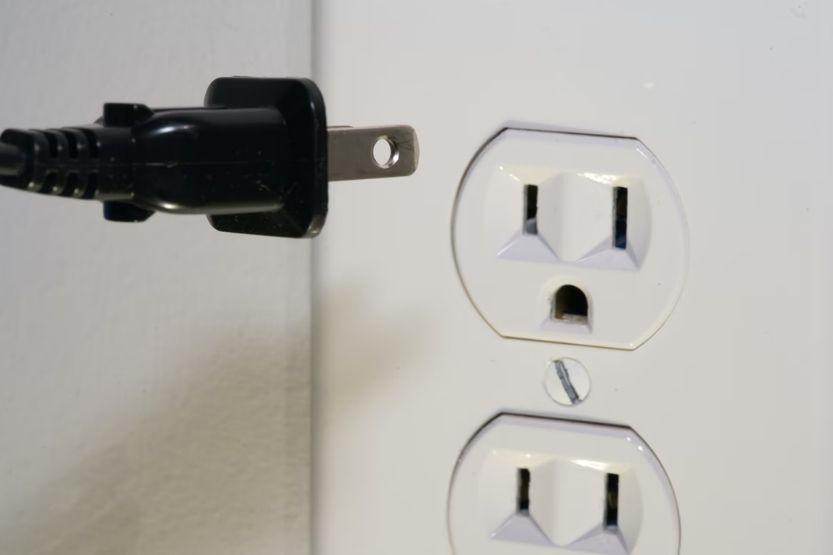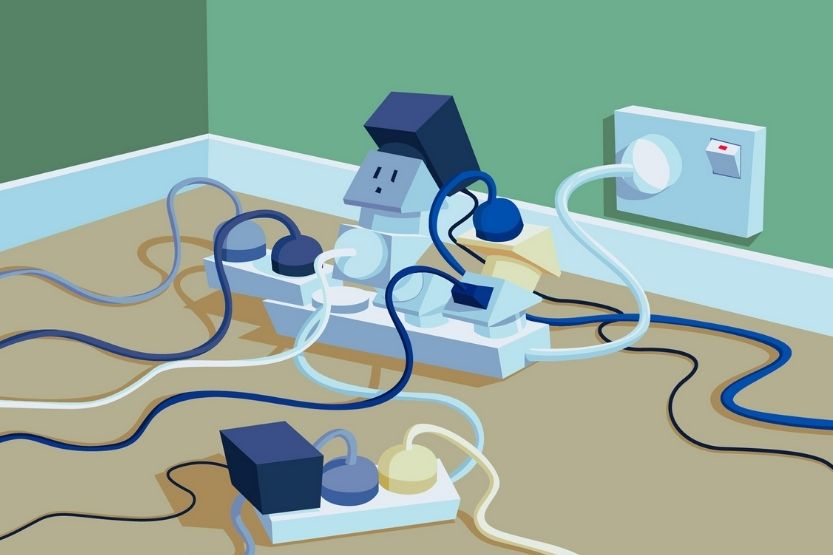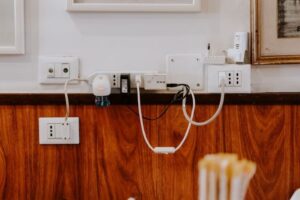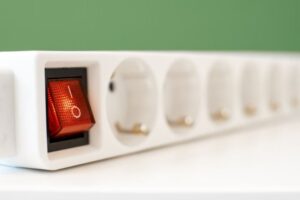The National Electric Code (NEC) does not provide any direct code regarding the number of outlets you can put in one circuit. However, they have set certain restrictions. So, how many outlets on a 20 amp circuit are safe?
Having ten outlets is the recommendation. The rule is 80% circuit and breaker load, allowing 1.5 maximum amps for every receptacle. Remember that the circuit, outlets, and wire sizes should all be compatible to prevent electrical hazards like overheating.
The maximum limit of 1.5 amps per receptacle is the rule of thumb that you should always follow. This rule allows a maximum of ten receptacles for every 20 amp circuit.
Read on to learn more about the number of outlets that you can safely put in one single 20 amp circuit and the important details related to this subject that you should know.
How Many Outlets on a 20 Amp Circuit?

The rule of thumb is to have no more than ten outlets for one 20 amp circuit. This number follows the 80% circuit and breaker load rule, allowing 1.5 amps as maximum load per outlet. Keep in mind that the wire sizes, outlets, and circuits should all be compatible with each other so that you can avoid electrical hazards like overheating.
This rule of thumb considers that you will not use all receptacles for drawing or receiving power. Even then, the NEC still placed a limit on the maximum power load that a circuit and its breaker should sustain. That limit is no greater than 80% of its indicated rating.
In other words, for every 20 amp circuit, that maximum allowable amp should not be greater than 16 amps. So, that translates to ten devices. In other words, you can’t put two devices in just one receptacle. For safety purposes, you should only connect one device to each outlet.
Capacity of a 20 amp Circuit
Most Common Rating Used in Devices
The 20 amp circuit is the most common rating used in devices like overhead lights, receptacles, and a 15-amp circuit. The usual circuit is adequate for powering one or two bedrooms.
Wire Sizes for Different Currents
Different wire sizes are used for different amps. For instance, a 20 amp circuit uses a 10 or 12 gauge wire, while a 15 amp circuit uses a 14 gauge wire. The lower the number, the thicker the wire is for electrical wires. A 12 gauge wire is 26% thicker than a 14 gauge wire.
So, if you use a 14 gauge wire in a 20 amp circuit, you can easily overload it. The 14 gauge wire is typically used for 15 amp circuits. For 20 amp circuits, the 10 to 12 gauge wire is the wire that is usually used.
It doesn’t mean that when the circuit’s rating is 20 amps, the current passing through is 20 amperes. This is only a way to indicate the right amount of power that the circuit can carry safely.
Cause of Overheating
When speaking of the number of receptacles or outlets you can put on a 20 amp circuit, there is no limit. However, you should remember that several devices’ power drawn out of the outlets simultaneously could overheat the wires.
This can cause the breaker to trip, or worse, it could trigger an electrical fire. So, it is important to evenly distribute the power drawn out of a 20 amp circuit into several outlets.
What Does the NEC Requires?
A Circuit Should Not Supply More Than 80% of the Circuit Breaker Limit
The National Electric Code requires that a circuit not supply more than 80% of the circuit breaker limit. This is required so that the circuit breaker will not always trip. It will also prevent electrical failure in your home.
Requires a 20 amp Circuit Breaker to Give a Current of No More Than 16 amp
According to this rule, you should only require a 20 amp circuit breaker to provide a current of no more than 16 amperes, 80% of 20 amps. To make it clearer, if you convert 16 amps to watts, you will get 1920 watts.
You know that watts = amps x 120 volts. U.S. homes are supplied with 120-volt circuits unless special appliances need a different voltage supply, such as dryers. So, you are not allowed to run more than 1920 watts on your 20 amp circuit every single time.
In Case of Power Surges
The 80% limit is recommended because you can’t assure that there will be no power surges every time you turn on a big appliance. Its power requirement could use up the 20% reserve power. This remaining power serves as the circuit’s free space.
To repeat, the 80% regulation for a 20 amp circuit is 1920 watts or 16 amps for the 120 volts system in U.S. households. You are limited to ten receptacles or outlets on your 20 amp circuit in complying with this rule. The calculation is 16 amps/1.5 amps = 10.67 outlets or just ten outlets.
Are There Standard Heights for Electrical Outlets?
How to Spread Your Load

To comply with the NEC regulation, you need to know how to distribute your 20 amp circuit load. One way of doing this is to spread out your power requirements over all the circuit breakers in the electrical panel.
You can combine electrical outlets and lights in one circuit. The reason is that lights usually use less power than appliances. There should at least be two outlets or receptacles in your kitchen.
Another way is to add lights to each circuit. This will balance the power load, and you can avoid creating separate circuits just for the lights only. Some kitchen appliances need dedicated circuits. For instance, the dishwasher should have its circuit. That means you cannot connect anything, even lights, in this dedicated circuit.
Again, how many outlets should be on a 20 amp circuit? To comply with the 80% circuit and breaker load rule, a 20 amp circuit should only have ten outlets. This allows a maximum of 1.5 amperes per receptacle. Also, to prevent overheating, ensure that the circuit, wire sizes, and outlets are all compatible.
What Happens When You Use Duct Tape Instead of Electrical Tape?
Managing Your Outlets Properly
Remember that every appliance you use in your home draws out power from the outlets. But since they are not all the same, the power they draw out from the mains is not the same either.
The bathroom and the kitchen are the parts of your house that draw the most power from your mains. They are your heaviest power consumers. If you use just one 20 amp circuit for your bathroom and your kitchen, things can go wrong.
You are risking your electrical wirings. They can overheat, and you will suffer electrical damages. You need to put up a plan that will safely distribute the power draw outs based on the requirement of every appliance and every light in all the rooms in your house.
How Do You Hide Outlets Under Cabinets?
Planning the Outlets
The best way to ensure that your 20 amp circuit can safely carry the power requirements of all your lights and appliances is to draw up a plan for your outlets before installing them. If you already have the outlets installed, it is a matter of correcting them or modifying how you use them.
Laying Out a Plan
Connect All the Lights to One Circuit
Let’s take up the first situation, laying out a plan. Begin by connecting all your lights to just one circuit. The primary reason for this is that the lights draw out power much less than your other electrical devices and appliances. This is also a safer practice.
Dedicate a 20 amp Circuit to the Electric Stoves and Dishwasher
You should dedicate a 20 amp circuit to the electric stoves and the dishwasher for your kitchen. It is also wiser to plan for two separate circuits and divide the outlets into these two circuits.
In this way, you will be able to balance the electrical load. You can also prevent the circuit breaker from tripping regularly.
Every Wall in a Bedroom Should Have an Electric Outlet
There is a general rule for your bedrooms that every wall in a bedroom should have an electrical outlet. You can follow this rule by installing an outlet every 6-feet of the wall width. Designating one 20 amp circuit for all the lights and outlets in a bedroom will be ok as well.
Always remember that regardless of the number of outlets you have in a circuit, it is more than likely that you will use only one or two of these outlets simultaneously. The best way is to spread out the outlets in places where you can access them easily.
Preventing Overloads
Determine the Number of Receptacles You Will Add to a 20 amp Circuit
You also need to determine the number of receptacles or outlets you want to add to a 20 amp circuit. You also need to think about the electrical devices and appliances you will plug into these outlets.
Follow the 80% Circuit and Breaker Rule
As I have already mentioned, for safety purposes, you should plan that the total power draws out of one circuit should be no more than 16 amps at any time. This equals 1,920 watts of total power drawn out for a standard 120-volt circuit. Follow this rule even if the breaker is designed not to trip until it exceeds 2,400 watts power draw out.
Limit the Number of Outlets
If you use the circuit to supply power to a big appliance, you should limit its number of outlets. For instance, if you use the circuit to power an electric heater, the outlets on the circuit should be limited to just a few. On average, electric heaters need 1,500 watts of electricity to run.
Line Vs. Load – What Is the Difference Between Them?
Determining the Number of Outlets on a 20 Amp Circuit

Circuit Breakers Protect the Electrical Wires from Overloading
The function of circuit breakers is to protect the electrical wires from overloading and overheating. If the circuit wires overload, they will eventually overheat. This could lead to electrical fires. So, you need to be sure that the number of outlets is just right for the circuit.
Utilize Circuits
While ten is the recommended number of outlets for every 20 amp circuit, you should also consider utilizing a particular circuit. For instance, garages, kitchens, and bathrooms have electrical devices that use more than 1.5 amps or 180 watts.
In contrast, your bedroom usually has lamps or lights and other electrical devices that use considerably less power. So, when you are thinking about the total number of outlets you can put in a 20 amp circuit, always use the worst-case scenario in your calculations.
Power Usage of Common Household Devices
Knowing the usual power usage of the common household electrical devices will help you calculate the number of outlets you will need for a 20 amp circuit. In this regard, the following table will be of much help to you:
| Electrical Device | Amperes | Watts |
| Lamp with LED Bulb | 0.08 | 10 |
| 60 inch LCD TV | 1.66 | 200 |
| Electric Space Heater | 12.5 | 1500 |
| Cell phone Charger | 0.04 | 5 |
| Curling Iron | 1.66 | 20 |
| Hair Dryer | 12.5 | 1500 |
| Toaster Oven | 10 | 1200 |
| Coffee Maker | 6.25 | 750 |
Conclusion: How Many Outlets on a 20 Amp Circuit?
Ten is the maximum number of outlets you can put in a single 20 amp circuit. The rule being followed here is 80% circuit and breaker load which says that one receptacle should only have a maximum of 1.5 amps.
Remember that the outlets, circuit, and wire sizes should be compatible to prevent electrical hazards such as overheating. You should follow the rule of thumb at all times, which designates that for every 20 amp circuit, the number of outlets must not exceed ten.
Read next:



![Wiring Outlets in Series [How-to Guide] wiring outlets in series](https://homecarezen.com/wp-content/uploads/2022/08/wiring-outlets-in-series-150x150.jpg)


